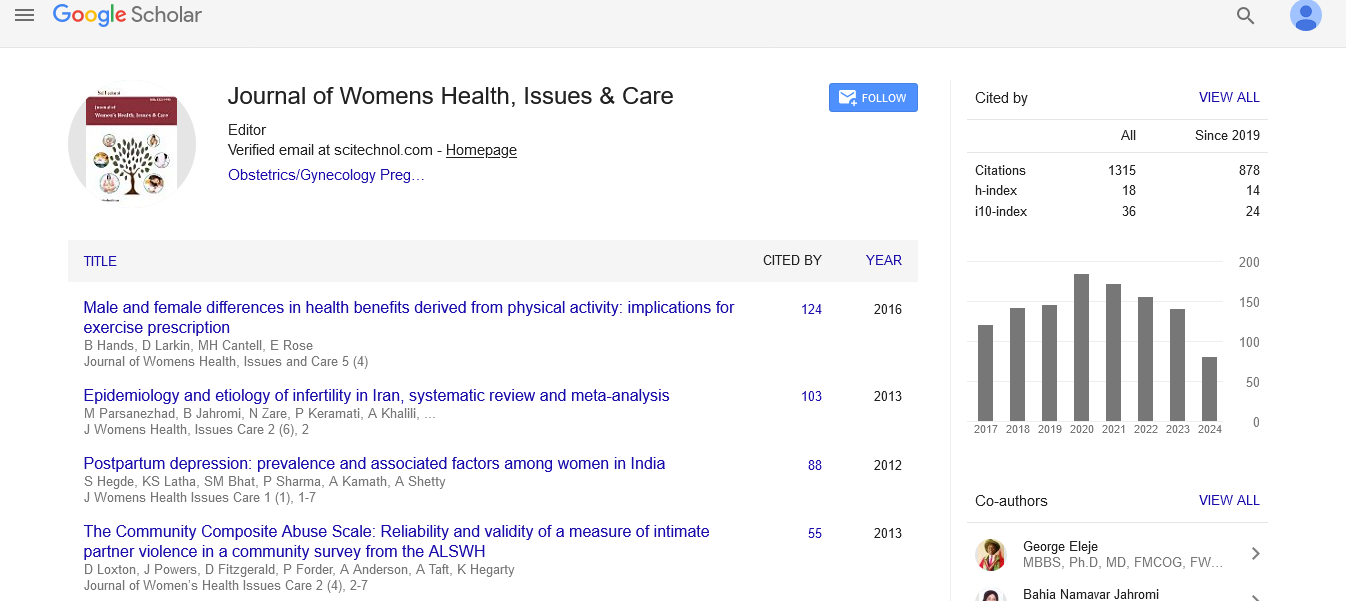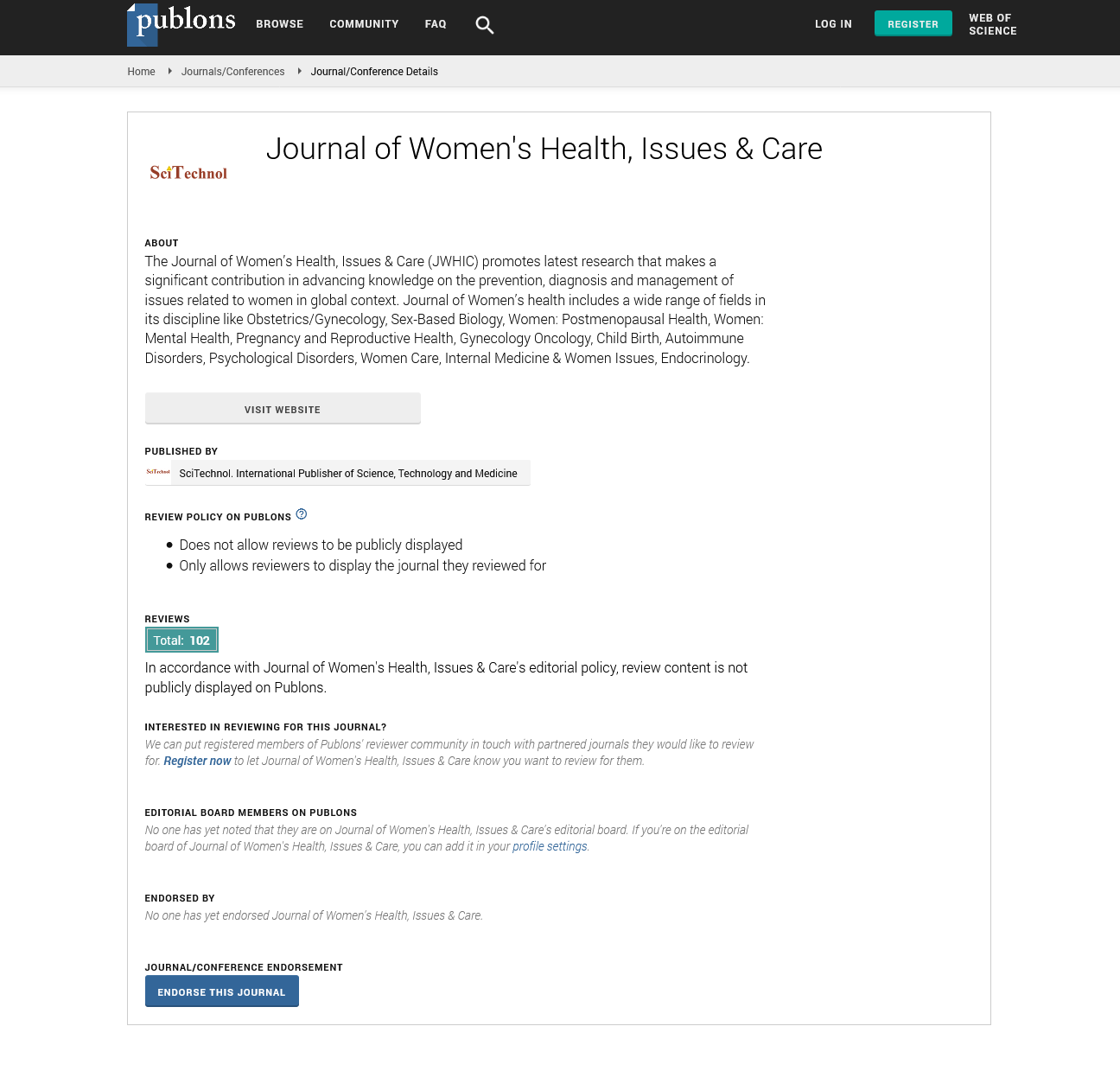Commentary, J Womens Health Vol: 13 Issue: 2
Managing Premenstrual Syndrome: Strategies for Symptom Relief and Well-Being
John Wilkins*
1Department of Gynecologic Oncology, University of Texas South-western, Texas, USA
*Corresponding Author: John Wilkins,
Department of Gynecologic Oncology,
University of Texas South-western, Texas, USA
E-mail: wilkinsjiohn@gmail.com
Received date: 27 March, 2024, Manuscript No. JWHIC-24-132530;
Editor assigned date: 29 March, 2024, PreQC No. JWHIC-24-132530 (PQ);
Reviewed date: 12 April, 2024, QC No. JWHIC-24-132530;
Revised date: 19 April, 2024, Manuscript No. JWHIC-24-132530 (R);
Published date: 29 April, 2024 DOI: 10.4172/2325-9795.1000491.
Citation: Wilkins J (2024) Managing Premenstrual Syndrome: Strategies for Symptom Relief and Well-Being. J Womens Health 13:2.
Description
Premenstrual Syndrome (PMS) is a common yet complex condition characterized by a diverse range of physical, emotional, and behavioral symptoms that occur cyclically in the luteal phase of the menstrual cycle. While many women experience mild symptoms, PMS can significantly impair daily functioning and quality of life for some individuals. Despite its prevalence and impact, the exact mechanisms underlying PMS remain elusive, and diagnosis can be challenging due to the subjective nature of symptoms.
Clinical presentation of PMS
PMS encompasses a broad spectrum of symptoms that typically emerge in the days leading up to menstruation and resolve shortly after the onset of menses. Common physical symptoms include breast tenderness, bloating, headaches, and fatigue, while emotional and psychological symptoms may include mood swings, irritability, anxiety, depression, and difficulty concentrating. The severity and duration of symptoms can vary widely among individuals, with some women experiencing mild discomfort and others experiencing profound impairment in daily functioning.
Etiology of PMS
The exact cause of PMS remains unclear, but it is thought to involve a complex interplay of hormonal, neurobiological, and psychosocial factors. Fluctuations in estrogen and progesterone levels during the menstrual cycle are believed to contribute to symptom onset, although the precise mechanisms are not fully understood. Additionally, neurotransmitter imbalances, genetic predisposition, and psychosocial stressors may influence susceptibility to PMS. While the etiology of PMS is likely multifactorial, further research is needed to elucidate the underlying mechanisms and identify potential therapeutic targets.
Risk factors for PMS
Several factors may increase the risk of experiencing PMS, including age, reproductive history, lifestyle factors, and coexisting medical conditions. Younger women, particularly those in their late teens to early thirties, are more likely to experience PMS, with symptoms often improving with age or after childbirth. Lifestyle factors such as poor diet, inadequate exercise, and high stress levels may exacerbate PMS symptoms, while coexisting conditions such as depression, anxiety, and chronic pain syndromes may amplify symptom severity. Understanding these risk factors is essential for customized management approaches and targeted interventions.
Management strategies for PMS
The management of PMS typically involves a combination of lifestyle modifications, pharmacotherapy, and psychological interventions aimed at alleviating symptoms and improving overall well-being. Lifestyle modifications may include dietary changes, regular exercise, stress reduction techniques, and adequate sleep hygiene. Pharmacotherapy options range from over-the-counter pain relievers and diuretics to hormonal contraceptives and Selective Serotonin Reuptake Inhibitors (SSRIs) for more severe symptoms. Psychological interventions such as Cognitive Behavioral Therapy (CBT) and mindfulness-based approaches may also help women cope with emotional and psychological aspects of PMS. A customized, multidisciplinary approach is often necessary to address the diverse needs of women affected by PMS and optimize treatment outcomes.
Conclusion
Premenstrual Syndrome (PMS) is a common yet complex condition that affects many women during their reproductive years. Despite its significant impact on quality of life, PMS remains poorly understood and often underdiagnosed. By gaining a deeper understanding of the clinical presentation, etiology, risk factors, and management strategies associated with PMS, healthcare providers can better support women affected by this condition. Further research is needed to elucidate the underlying mechanisms of PMS and develop more targeted interventions to improve the well-being for women worldwide.
 Spanish
Spanish  Chinese
Chinese  Russian
Russian  German
German  French
French  Japanese
Japanese  Portuguese
Portuguese  Hindi
Hindi 



